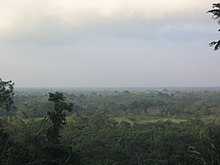Selva Lacandona
The Selva Lacandona ( German "Lacandonischer Wald" ) is a primeval forest area in the east of the Mexican state Chiapas on the border with Guatemala .
location
The Selva Lacandona belongs to the Montes Azules biosphere reserve and is closed to the east for about 150 km by the Río Lacantún , which belongs to the river basin of the Río Usumacinta .
History and present
In the Selva Lacandona there are several famous ruins of the classical Maya , such as B. Bonampak and Yaxchilán . During the colonial period, the Lacandon Indians immigrated to the area, whose home and documented property it is today.
Since the 1990s, the relatively impassable woodland of Chiapas has also been the operational area of the Zapatista Liberation Army EZLN , which has established autonomous indigenous communities in some villages in the region , whose claims to self-government today (2006) by the Mexican state z. T. are recognized. However, the basis of the EZLN is not the Lacandons, who are opposed to the EZLN, but indigenous people from other Maya ethnic groups, such as the Tzotzil . Several official statements by the EZLN have the title (x.) Declaration from the Lacandonian Primeval Forest .
Honey production
In the Selva Lacandona is honey Lacandona prepared the note in 2009 as "satisfactory" at the Stiftung Warentest received. In 2004, as the second best mixed flower honey, it still achieved the quality rating “good” (grade 1.9). Lacandona comes from fair trade and is produced by small farmers in the region near Selva Lacandona.
See also
Web links
Individual evidence
- ↑ B. Ammann: Mexico's remaining primeval forest as a field of conflict. In: Neue Zürcher Zeitung NZZ, October 9, 2003, Abroad, September 9
- ↑ http://www.chiapas.at/sonderseiten/latein America/ montes_azules.doc
- ↑ Honey test of the Stiftung Warentest test, 02/2009
- ↑ Mixed flower honeys. In: test 4/2004. Stiftung Warentest , March 25, 2004, accessed on January 19, 2013 .
Coordinates: 16 ° 28 ′ N , 91 ° 10 ′ W


